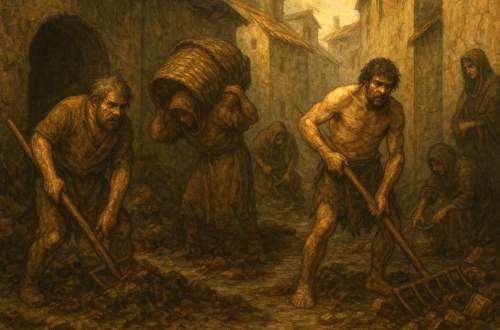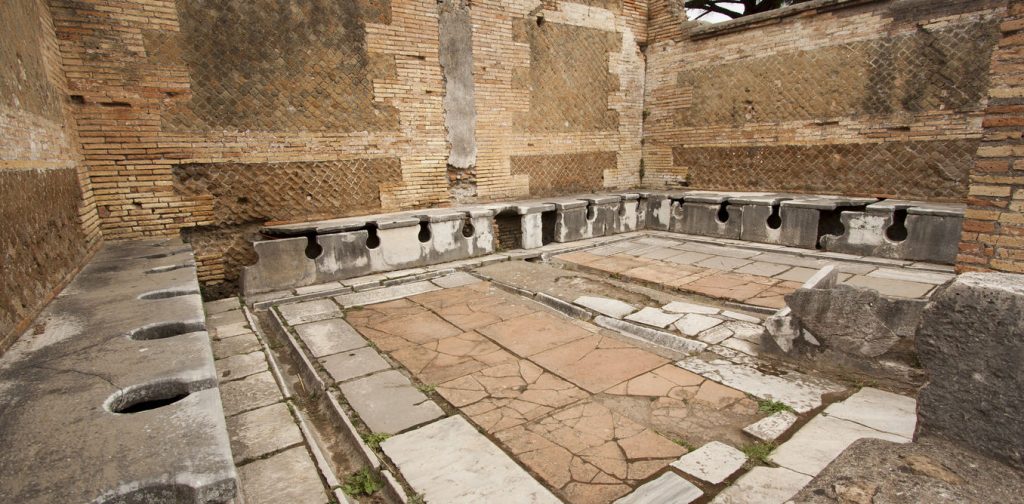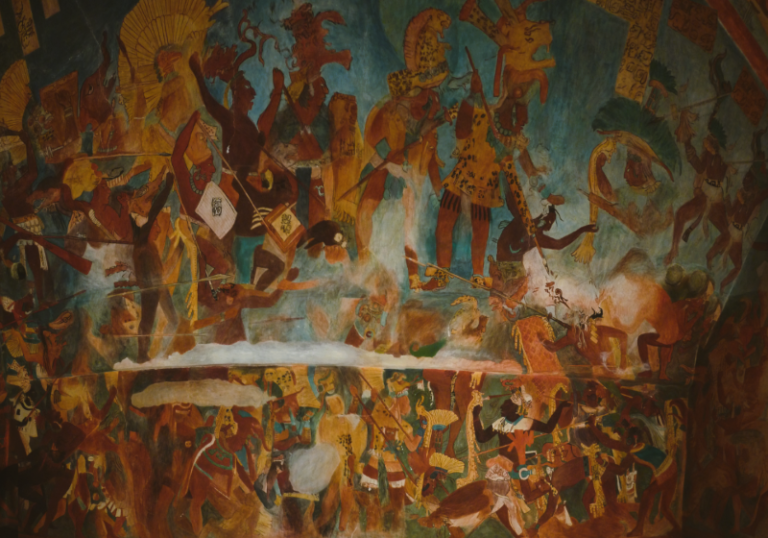

The history of work is not only a chronicle of innovation and achievement. It is also a history of suffering, of the bodies consumed in filth, danger, and stigma.

By Matthew A. McIntosh
Public Historian
Brewminate
Introduction
Across antiquity and the Middle Ages, civilizations celebrated the glory of kings, the brilliance of philosophers, and the might of generals. Yet beneath this exalted surface existed a hidden substratum of labor that sustained the whole. Societies cannot function without waste removal, food preparation, or raw material extraction. The men and women who performed such work, however, were often despised, forgotten, or literally buried by their tasks.
Those “worst jobs” defined the margins of survival. They fall broadly into three categories: the filthy, who labored in the stench of waste and decay; the endangered, whose bodies were consumed by dangerous tasks; and the stigmatized, who bore the moral or social weight of necessary but dishonored functions. These categories overlap, yet together they expose the underside of civilizations often idealized in memory.
The Labors of Filth
Waste and the Human Body

Few occupations evoke misery more vividly than those dealing with human excrement. In ancient Rome, sewer cleaners navigated the vast Cloaca Maxima, scraping blockages from tunnels where collapse, drowning, and suffocation were constant threats.1 Medieval England had its gong farmers, men who descended into cesspits by night to shovel human waste, sometimes drowning in their work when walls collapsed.2
Equally loathed were the night soil men, who carted buckets of waste through city streets for disposal outside the walls. These labors, indispensable to urban health, rendered their practitioners outcasts, avoided in daylight yet relied upon in silence.3
Filth of Animal Origins
The tanning industry was equally reviled. Ancient and medieval tanners softened hides with dung and urine, while fullers in Rome cleansed cloth in vats of fermented urine.4 Butchers and knackers stood ankle-deep in blood and gore, their work necessary but their touch considered contaminating.5
Filth was not always material. It was ritual and symbolic. These workers embodied the pollution that society sought to contain, marking them as necessary pariahs.
The Labors of Danger
Beneath the Earth

Mining was among the most lethal professions. In antiquity, silver miners at Laurion in Greece or salt miners in North Africa endured suffocating air, falling rock, and exhaustion that ended lives early.6 Roman writers described mines as death sentences for slaves. The men who bailed water from shafts, or who dug tunnels beneath city walls during sieges, faced sudden death from collapse.7
Quarry workers who split stone or brickmakers tending smoky kilns did not face instant death, but their bodies decayed under unending strain. The rock that built temples and amphitheaters was extracted at the cost of anonymous lives.8
On the Water and at War
Other dangers came from service at sea. Galley rowers, often slaves or prisoners, were chained to oars, whipped for endurance, and left to die when ships sank.9 Ship bilge cleaners worked in the lowest decks, scraping rot and sludge among rats.10
On land, mercenaries and foot soldiers faced constant risk for meager pay. Few expected long lives, and fewer still enjoyed honorable remembrance. Their expendability mirrored that of miners, only with steel instead of stone as the hazard.11
At the Edge of Science and Nature
The search for healing bred peculiar dangers. Leech collectors waded into bogs, letting leeches attach until they bled profusely, risking infection for paltry rewards.12 Assistants in alchemical workshops inhaled fumes of mercury and arsenic, poisoned by their masters’ ambitions.13
Even seemingly mundane tasks could be lethal. Bell ringers working in tall towers risked deafness, falls, and lightning strikes.14 Lamp lighters, climbing nightly with open flames, carried their mortality on a pole.15
The Labors of Stigma
Blood, Death, and Contamination

Few roles carried heavier stigma than that of the executioner. Charged with carrying out the law’s most visible punishments, executioners lived at the edge of society. Their touch was shunned, their families avoided, yet their services were indispensable.16 Torturers shared this fate, as did plague corpse collectors, who carried away the dead in times of pestilence.17
Gladiators, though sometimes celebrated, also occupied ambiguous status. Many were slaves or prisoners of war, forced to shed blood for entertainment. Their deaths were spectacles, their lives degraded currency.18
The Diminished Dignity of Service
Not all stigma came from death. Scullery workers, lowest in kitchen hierarchies, handled rancid scraps and grease in suffocating heat. Water carriers, essential to households before plumbing, broke their backs for little dignity.19 Even tavern workers and slaves lived under constant threat of violence from clientele, despised for serving and vulnerable to harm.20
The treadmill operator, condemned to endless walking in a wooden wheel to power mills or cranes, embodied a life reduced to motion without purpose. In some cases, animals replaced humans, but where men remained, the job symbolized pure drudgery.21
The Necessity of the Miserable
Civilizations are remembered for their monuments and philosophies, yet the endurance of the miserable sustained them. Cities could not thrive without sewage removal, nor armies march without leather, nor temples rise without quarried stone. The very luxuries celebrated in art and literature were extracted through the despised labor of others.22
This paradox defined both antiquity and the Middle Ages. Work that was essential was marked as degrading. Laborers were not valued for their contribution but shunned for their contact with the unclean or the dangerous. Their anonymity was deliberate: society preferred to forget the hands that held its foundations steady.
Conclusion
The history of work is not only a chronicle of innovation and achievement. It is also a history of suffering, of the bodies consumed in filth, danger, and stigma. Ancient and medieval laborers endured conditions that reduced human life to expendable utility. Their presence was tolerated only as long as their work was needed, and their absence mourned only in the crises that followed neglect.
To recall these labors today is to illuminate the shadows of past societies. Every amphitheater, every cathedral, every paved street stands on the bent backs of those who toiled unseen. Their jobs were the worst imaginable, but their legacy endures in the stones, sewers, and scars of history itself.
Appendix
Footnotes
- Trevor Hodge, Roman Aqueducts and Water Supply (London: Duckworth, 1992), 118–120.
- Richard Jones, Manure Matters: Historical, Archaeological and Ethnographic Perspectives (Farnham: Ashgate, 2012), 87–90.
- Dolly Jørgensen, The Medieval Pig (London: Boydell Press, 2024), 55–58.
- Miko Flohr, The World of the Fullo: Work, Economy, and Society in Roman Italy (Oxford: Oxford University Press, 2013), 142–148.
- Susan Stuart, Defiled Trades and Social Outcasts (Cambridge: Cambridge University Press, 2006), 73–77.
- David T. Murphy, Pliny the Elder’s Natural History: The Empire in the Encyclopedia (Oxford: Oxford University Press, 2004), 202–206.
- Victor Davis Hanson, Warfare and Agriculture in Classical Greece (Berkeley: University of California Press, 1983), 162–165.
- Adam T. Smith, The Political Landscape: Constellations of Authority in Early Complex Polities (Berkeley: University of California Press, 2003), 191–193.
- Lionel Casson, The Ancient Mariners (Princeton: Princeton University Press, 1959), 125–128.
- Brian Lavery, The Arming and Fitting of English Ships of War (London: Conway Maritime Press, 1987), 211–214.
- John France, Mercenaries and Paid Men: The Mercenary Identity in the Middle Ages (Leiden: Brill, 2008), 31–35.
- Louise Hill Curth, English Almanacs, Astrology and Popular Medicine (Manchester: Manchester University Press, 2008), 202.
- William R. Newman, Promethean Ambitions: Alchemy and the Quest to Perfect Nature (Chicago: University of Chicago Press, 2004), 93–96.
- Gabriella di Cagno, Florence: The Cathedral, the Baptistery and the Campanile (Florence: Mandragora, 2000), 73.
- James Crossley, Class Struggle in the New Testament (Minneapolis: Fortress Academic, 2021), 49–51.
- Joel Harrington, The Faithful Executioner: Life and Death, Honor and Shame in the Turbulent Sixteenth Century (New York: Farrar, Straus and Giroux, 2013), 24–28.
- Ole J. Benedictow, The Black Death, 1346–1353: The Complete History (Woodbridge: Boydell, 2004), 213–216.
- Roger Dunkle, Gladiators: Violence and Spectacle in Ancient Rome (London: Routledge, 2008), 85–90.
- Barbara Hanawalt, The Ties That Bound: Peasant Families in Medieval England (Oxford: Oxford University Press, 1986), 151–153.
- Judith Bennett, Ale, Beer, and Brewsters in England: Women’s Work in a Changing World, 1300–1600 (Oxford: Oxford University Press, 1996), 122–124.
- E. M. Carus-Wilson, Medieval Merchant Venturers (London: Methuen, 1954), 97–100.
- Fernand Braudel, The Structures of Everyday Life (New York: Harper and Row, 1985), 321–324.
Bibliography
- Benedictow, Ole J. The Black Death, 1346–1353: The Complete History. Woodbridge: Boydell, 2004.
- Bennett, Judith. Ale, Beer, and Brewsters in England: Women’s Work in a Changing World, 1300–1600. Oxford: Oxford University Press, 1996.
- Braudel, Fernand. The Structures of Everyday Life. New York: Harper and Row, 1985.
- Carus-Wilson, E. M. Medieval Merchant Venturers. London: Methuen, 1954.
- Casson, Lionel. The Ancient Mariners. Princeton: Princeton University Press, 1959.
- Crossley, James. Class Struggle in the New Testament. Minneapolis: Fortress Academic, 2021.
- Curth, Louise Hill. English Almanacs, Astrology and Popular Medicine. Manchester: Manchester University Press, 2008.
- di Cagno, Gabriella. Florence: The Cathedral, the Baptistery and the Campanile. Florence: Mandragora, 2000.
- Dunkle, Roger. Gladiators: Violence and Spectacle in Ancient Rome. London: Routledge, 2008.
- Flohr, Miko. The World of the Fullo: Work, Economy, and Society in Roman Italy. Oxford: Oxford University Press, 2013.
- France, John. Mercenaries and Paid Men: The Mercenary Identity in the Middle Ages. Leiden: Brill, 2008.
- Hanson, Victor Davis. Warfare and Agriculture in Classical Greece. Berkeley: University of California Press, 1983.
- Hanawalt, Barbara. The Ties That Bound: Peasant Families in Medieval England. Oxford: Oxford University Press, 1986.
- Harrington, Joel. The Faithful Executioner: Life and Death, Honor and Shame in the Turbulent Sixteenth Century. New York: Farrar, Straus and Giroux, 2013.
- Hodge, A. Trevor. Roman Aqueducts and Water Supply. London: Duckworth, 1992.
- Jørgensen, Dolly. The Medieval Pig. London: Boydell Press, 2024.
- Jones, Richard. Manure Matters: Historical, Archaeological and Ethnographic Perspectives. Farnham: Ashgate, 2012.
- Lavery, Brian. The Arming and Fitting of English Ships of War. London: Conway Maritime Press, 1987.
- Murphy, David T. Pliny the Elder’s Natural History: The Empire in the Encyclopedia. Oxford: Oxford University Press, 2004.
- Newman, William R. Promethean Ambitions: Alchemy and the Quest to Perfect Nature. Chicago: University of Chicago Press, 2004.
- Smith, Adam T. The Political Landscape: Constellations of Authority in Early Complex Polities. Berkeley: University of California Press, 2003.
- Stuart, Susan. Defiled Trades and Social Outcasts. Cambridge: Cambridge University Press, 2006.
Originally published by Brewminate, 09.08.2025, under the terms of a Creative Commons Attribution-NonCommercial-NoDerivatives 4.0 International license.


